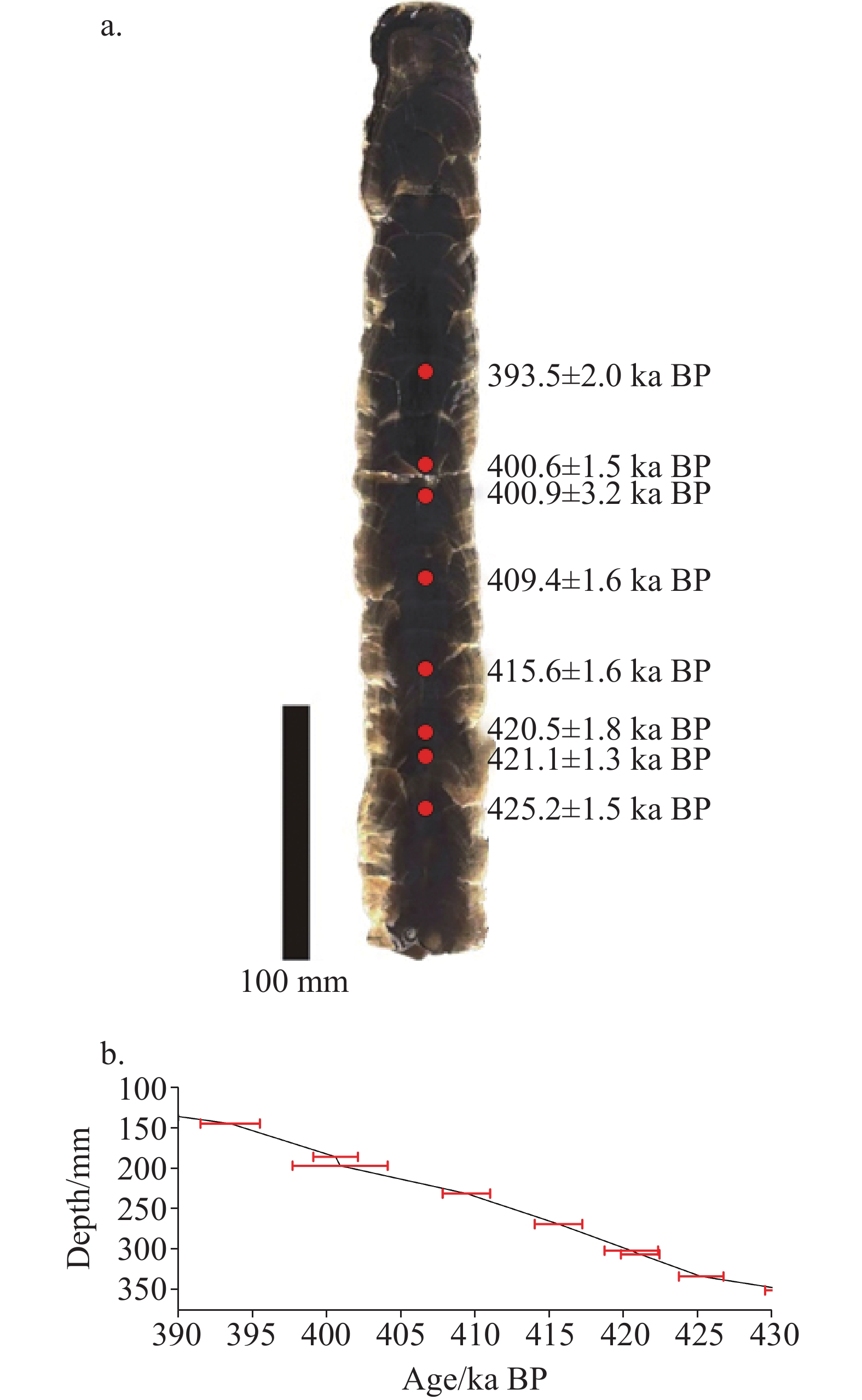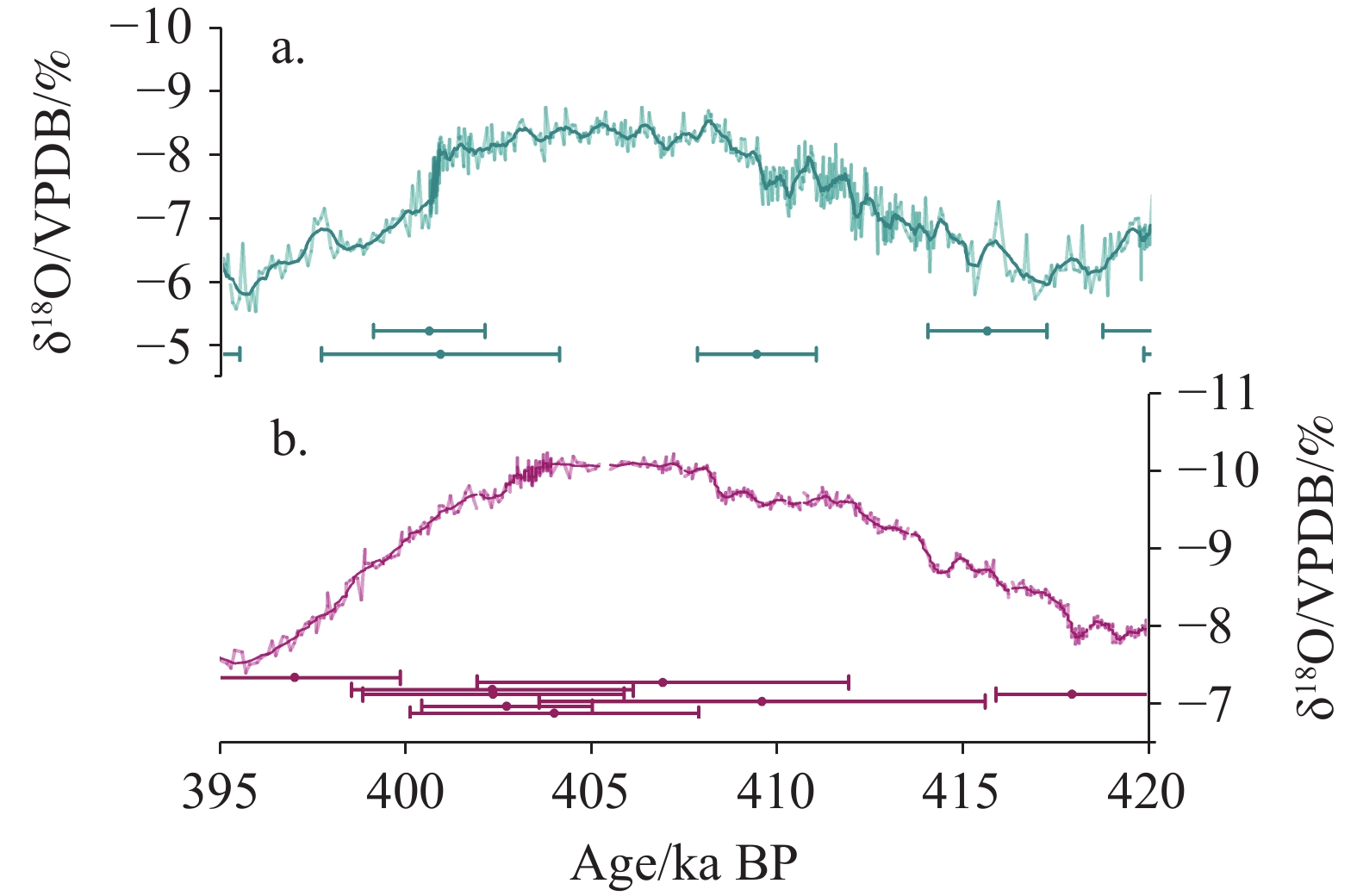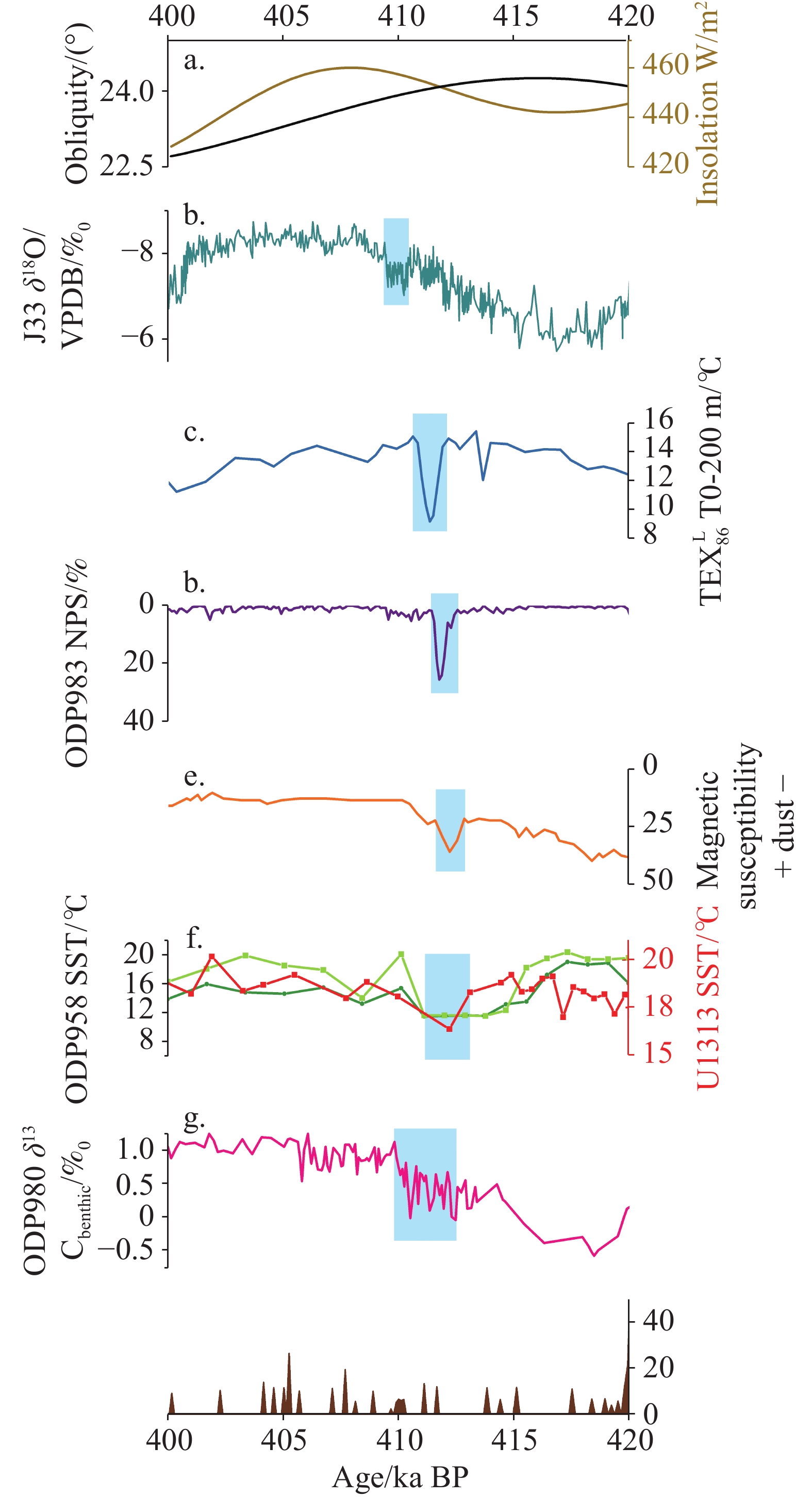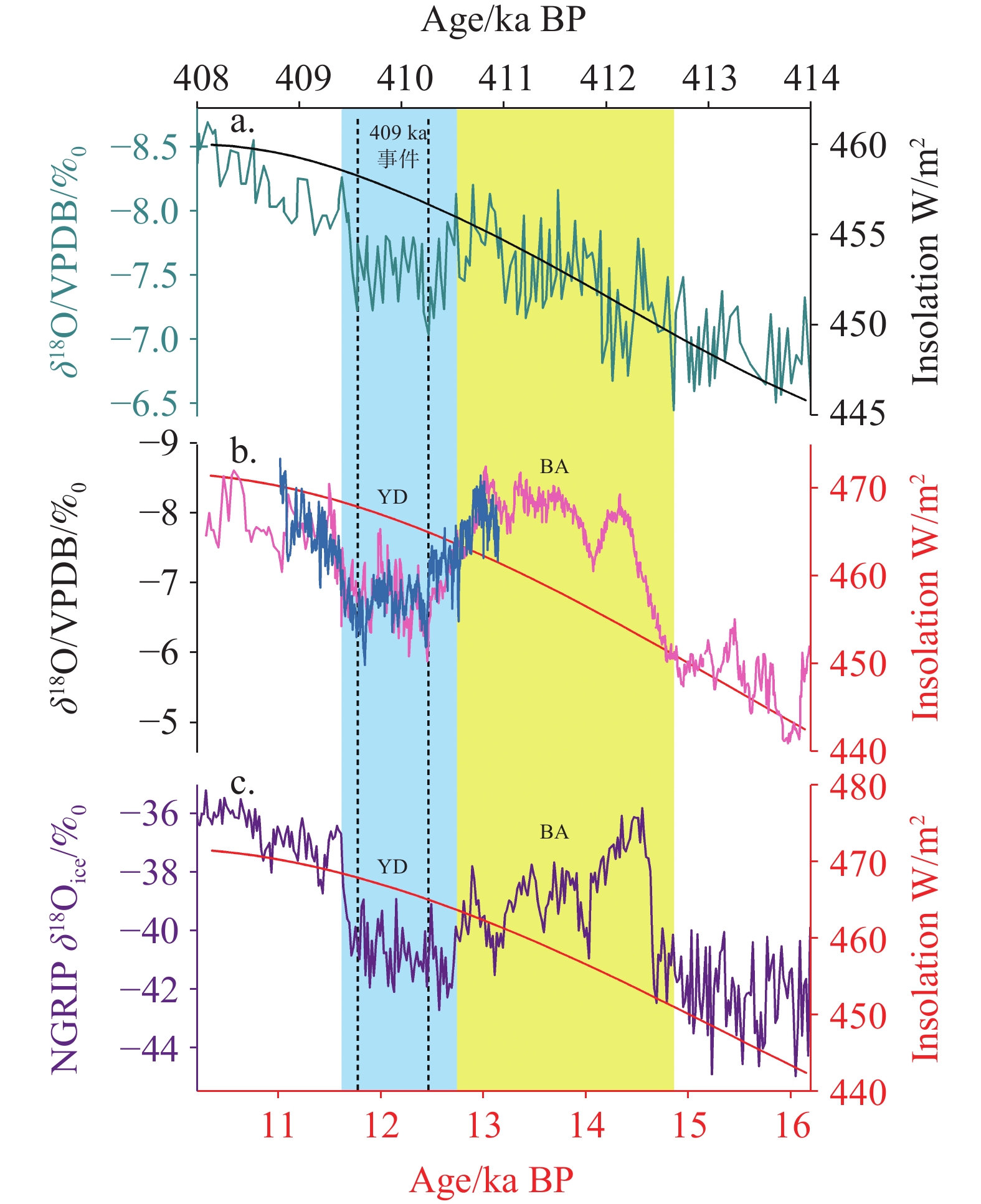410 ka weak monsoon event recorded by stalagmites in Jinfo Cave of Chongqing
-
Abstract:
The freshwater discharge from melting ice sheets in the deglaciation or glaciation is prone to anomalies in ocean−atmosphere transport between different latitudes, which can lead to a series of abrupt millennial-scale climate events, either obvious or not, such as the Younger Dryas (YD) events and YD-like events. Marine Isotope Stage 11c (MIS 11c) serves as one of the best references for the current Holocene, and the studies of possible YD-like events and their triggering mechanisms during Holocene are conducive to the understanding of the occurrence pattern of extreme climate events. In this paper, the results of the study on the J33 δ18O sequence records of stalagmites in Jinfo Cave, Chongqing, are shown: (1) Stalagmites in the Asian monsoon climate zone reveal a millennial-scale weak monsoon event that occurred around 410 ka BP prior to the Glacial Maximum of MIS 11 interglacial period. (2) Both the 410 ka weak monsoon event and the YD event occurred during the gradual strengthening of the monsoon and ascending branch of summer insolation in the Northern Hemisphere prior to the Glacial Maximum of interglacial period. This was also a time when Atlantic Meridional Overturning Circulation (AMOC) disturbance occurred. The duration, internal structure, and pattern of the events were similar, with differences in the change magnitude and ice volume conditions. (3) The weak monsoon event that occurred in 410 ka BP was primarily influenced by the combined effects of insolation and AMOC. This event was characterized by a sustained warming process that accelerated the melting of the Greenland ice sheet, leading to the destabilization of this ice sheet. The continuous flowing of freshwater into the North Atlantic resulted in a short-lived AMOC oscillation. The weakening of the AMOC resulted in a cold anomaly over the North Atlantic. As a result of atmospheric telecorrelation, the weaker AMOC led to a weaker Asian Summer Monsoon (ASM)
-
Key words:
- Asian Summer Monsoon /
- MIS 11c /
- stalagmite δ18O /
- weak monsoon event /
- Jinfo Cave /
- Southwest China
-

-
Table 1. 230Th date results for stalagmite J33 (‘*’ indicates the new measured data.)
Sample
NumberDepth
(mm)238U
(ppb)232Th
(ppt)230Th / 232Th
(atomic×10−6)δ234U
(measured)230Th / 238U
(activity)Age (ka BP)
(uncorrected)Age (ka BP)
(corrected)δ234UInitial
(corrected)J33-1 144.9 2516.4±0.1 884.9±10.2 72003.1±832.5 424.5±0.3 1.536±0.001 393.5±2.0 393.5±2.0 1288.5±7.5 J33-2 185.7 2875.4±0.1 429.4±10.7 167329.4±4184.0 406.4±0.3 1.516±0.001 400.6±1.5 400.6±1.5 1258.9±5.3 J33-3 196.9 2158.7±0.1 2182.9±11.0 24635.3±127.0 402.8±0.3 1.511±0.002 400.9±3.2 400.9±3.2 1248.6±11.2 J33-4 230.9 3113.8±0.2 1397.6±9.8 55814.2±391.3 406.0±0.3 1.519±0.001 409.4±1.6 409.4±1.6 1288.8±5.9 J33-5 268.7 2791.5±0.2 738.7±28.7 95730.9±3715.6 416.4±0.3 1.536±0.001 415.6±1.6 415.6±1.6 1345.7±6.1 J33-6 301.2 2906.0±0.1 479.0±8.4 154689.1±2718.8 422.2±0.3 1.546±0.001 420.5±1.8 420.5±1.8 1383.2±7.1 J33-7* 306.0 3621.9±8.7 672.0±1.6 137821.0±39.0 425.2±0.3 1.551±0.000 421.1±1.3 421.1±1.3 1395.4±5.3 J33-8* 333.0 3173.3±7.7 607.6±1.5 134437.0±38.0 431.6±0.4 1.561±0.000 425.2±1.5 425.2±1.5 1432.7±6.2 U decay constants: λ238 = 1.55125×10−10[13] and λ234 = 2.82206×10−6[9]. Th decay constant: λ230 = 9.1705×10−6[11]. δ234U = ([234U/238U] activity − 1) ×1000. δ234Uinitial was calculated based on 230Th age (T), i.e., δ234Uinitial = δ234Umeasured×eλ234×T. Corrected 230Th ages assume the initial 230Th/232Th atomic ratio of 4.4±2.2×10−6. Those are the values for a material at secular equilibrium, with the bulk earth 232Th/238U value of 3.8. The errors are arbitrarily assumed to be 50%. "BP" stands for "Before Present" where the "Present" is defined as the year 1950 CE. -
[1] Schulz M, Paul A, Timmermann A. Relaxation oscillators in concert: A framework for climate change at millennial timescales during the late Pleistocene[J]. Geophysical Research Letters, 2002, 29(24): 2193-2197.
[2] Sima A, Paul A, Schulz M. The Younger Dryas-an intrinsic feature of late pleistocene climate change at millennial timescales[J]. Earth and Planetary Science Letters, 2004, 222(3-4): 741-750. doi: 10.1016/j.jpgl.2004.03.026
[3] [4] Cheng H, Edwards R L, Broecker W S, Denton G H, Kong X G, Wang Y J, Zhang R, Wang X F. Ice age terminations[J]. Science, 2009, 326(5950): 248-252. doi: 10.1126/science.1177840
[5] Duan W H, Cheng H, Tan M, Ma Z B, Chen S T, Wang L S, Wang X F, Cui L L. Structural similarity between Termination III and I[J]. Quaternary Science Reviews, 2022(296): 0277-3791.
[6] 赵彬. MIS11阶段亚洲夏季风演化的高分辨率落水洞记录[D]. 南京:南京师范大学, 2019.
[7] Berger A L, Loutre M F. Climate 400,000 years ago, a key to the future?[A]//Droxler A W, Poore R Z, Burckle L H. Earth's Climate and Orbital Eccentricity: The Marine Isotope Stage 11 Question. Washington, D C: American Geophysical Union,, 2003, 137: 17-26. doi: 10.1016/S0921-8181(02)00186-8
[8] LIU Dianbing. Recent progress on studies of the spatial structure and dynamics for the Younger Dryas Event[J]. Geological Review, 2012, 58(2): 341-349.
[9] WANG Jianli, HE Xiao, WANG Xinya, ZHANG Meiliang, LIN Yushi. Isotopic ages and paleoclimatic information from stalagmites of Chongqing Jinfushan[J]. Carsologica Sinica, 2005, 24(4): 265-269.
[10] ZHANG Ren, ZHU Xuewen, HAN Daoshan, ZHANG Yuanhai, FANG Fengbao. Preliminary study on karst caves of Mt. Jinfo, Nanchuan, Chongqing[J]. Carsologica Sinica, 1998, 17(3): 196-211.
[11] Cheng H, Edwards R L, Shen C C, Polyak V J, Asmerom Y, Woodhead J, Hellstrom J, Wang Y J, Kong X G, Spötl C, Wang X F, Alexander Jr E C. Improvements in 230Th dating, 230Th and 234U half-life values, and U-Th isotopic measurements by multi-collector inductively coupled plasma mass spectrometry[J]. Earth and Planetary Science Letters, 2013, 371-372(1): 82-91.
[12] LI Chensi. Study on climate change of stalagmite records in Chongqing area during MIS 11[D]. Chongqing: Southwest University, 2015
[13] Jaffey A H, Flynn K F, Glendenin L E, Bentley W C, Essling A M. Precision measurement of half-lives and specific activities of 235U and 238U[J]. Physical Review C, 1971, 4(5): 1889-1906. doi: 10.1103/PhysRevC.4.1889
[14] Cheng H, Edwards R L, Sinha A, Spötl C, Yi L, Chen S T, Kelly M, kathayat G, Wang X F, Li X L, Kong X G, Wang Y J, Ning Y F, Zhang H W. The Asian monsoon over the past 640, 000 years and ice age terminations[J]. Nature, 2016, 534(7609): 640-646. doi: 10.1038/nature18591
[15] Dorale J A, Liu Z H. Limitations of hendy test criteria in judging the paleoclimatic suitability of speleothems and the need for replication[J]. Journal of Cave and Karst Studies, 2009, 71(1): 73-80.
[16] Cheng H, Sinha A, Wang X F, Cruz F W, Edwards R L. The global paleomonsoon as seen through speleothem records from Asia and the Americas[J]. Climate Dynamics, 2012, 39(5): 1045-1062. doi: 10.1007/s00382-012-1363-7
[17] QIN Jiaming, LIN Yushi, ZHANG Meiliang, WANG Hua, FENG Yumei, TU Linling. Change of the east-Asian monsoon climate during the last Glaciation : δ18O records of stalagmites in Qixing cave, Duyun City, Guizhou Province[J]. Carsologica Sinica, 2003, 22(3): 167-173.
[18] Liu Z Y, Wen X Y, Brady E C. Chinese cave records and the East Asia summer monsoon[J]. Quaternary Science Reviews, 2014, 83(1): 115-128.
[19] Zhang W H, Wu J Y, Wang Y, Wang Y J, Cheng H, Kong X G, Duan F C. A detailed East Asian monsoon history surrounding the 'Mystery Interval' derived from three Chinese speleothem records[J]. Quaternary Research, 2014, 82(1): 154-163. doi: 10.1016/j.yqres.2014.01.010
[20] Porter S, Zhisheng A. Correlation between climate events in the North Atlantic and China during the last glaciation[J]. Nature, 1995, 375: 305-308. doi: 10.1038/375305a0
[21] Rohling E J, Braun K, Grant K, Kucera M, Roberts A P, Siddall M, Trommer G. Comparison between Holocene and Marine Isotope Stage-11 sea-level histories[J]. Earth and Planetary Science Letters, 2010, 291(1-4): 96-105.
[22] Laskar J, Robutel P, Joutel F, Gastineau M, Correia A C M, Levrard B. A long-term numerical solution for the insolation quantities of the Earth[J]. Astronomy and Astrophysics, 2004, 428(1): 261-285. doi: 10.1051/0004-6361:20041335
[23] Kandiano E S, Meer M, Schouten S, Fahl Kirsten, Sinninghe Damsté J S, Bauch H A. Response of the North Atlantic surface and intermediate ocean structure to climate warming of MIS 11[J]. Scientific Reports, 2017, 7(1): 46192. doi: 10.1038/srep46192
[24] Barker S, Chen J, Gong X, Jonkers L, Knorr G, Thornalley D. Icebergs not the trigger for North Atlantic cold events[J]. Nature Geoscience, 2015, 520: 333-336.
[25] Kandiano E S, Bauch H A, Fahl K, Helmke J P, Röhl U, Pérez Folgado M, Cacho I. The meridional temperature gradient in the eastern North Atlantic during MI S11 and its link to the ocean–atmosphere system[J]. Palaeogeography, Palaeoclimatology, Palaeoecology, 2012, 333-334: 24-39. doi: 10.1016/j.palaeo.2012.03.005
[26] Stein R, Hefter J, Grützner J, Voelker A, Naafs B D A. Variability of surface water characteristics and Heinrich-like events in the Pleistocene midlatitude North Atlantic Ocean: Biomarker and XRD records from IODP Site U1313 (MIS16–9)[J]. Paleoceanography, 2009, 24(2): 2203.
[27] McManus J F, Oppo D W, Cullen J L, Healey S L. Marine isotope stage 11 (MIS 11): Analog for Holocene and future climate?[A]//Droxler A W, Poore R Z, Burckle L H. Earth's Climate and Orbital Eccentricity: The Marine Isotope Stage 11 Question. Washington D C: American Geophysical Union, 2003: 69-85.
[28] Prokopenko A A, Bezrukova E V, Khursevich G K, Solotchina E P, Kuzmin M I, Tarasov P E. Climate in continental interior Asia during the longest interglacial of the past 500,000 years: The new MIS 11 records for Lake Baikal, SE Siberia[J]. Climate of the Past, 2010, 6(1): 31-48. doi: 10.5194/cp-6-31-2010
[29] Oliveira D, Desprat S, Rodrigues T, Naughton F, Hodell D, Trigo R, Goni M. The complexity of millennial-scale variability in Southwestern Europe during MIS 11[J]. Quaternary Research, 2016, 86(3): 373-387. doi: 10.1016/j.yqres.2016.09.002
[30] Tzedakis P C, Pälike H, Roucoux K H, de Abreu L. Atmospheric methane, Southern European vegetation and low-mid latitude links on orbital and millennial timescales[J]. Earth and Planetary Science Letters, 2009, 277(3-4): 307-317. doi: 10.1016/j.jpgl.2008.10.027
[31] Dickson A J, Beer C, Dempsey C J, Dempsey C, Maslin M A, Bendle J A, McClymont E L, Pancost R D. Oceanic forcing of the Marine Isotope Stage 11 interglacial[J]. Nature Geoscience, 2009, 2(6): 428-433. doi: 10.1038/ngeo527
[32] ZHANG Taotao, LI Tingyong, HAN Liyin, CHENG Hai, LI Junyun, ZHAO Xin, ZHOU Jingli. Variation of the Asian summer monsoon during the MIS 5a/5b period inferred from a new high-resolution stalagmite record[J]. Carsologica Sinica, 2017, 36(2): 162-170.
[33] John M D, Yuet F L, Christelle N, Dirk E, Henning A B, Adina P, Benoit T. Freshening, stratification and deep-water formation in the Nordic Seas during Marine Isotope Stage 11[J]. Quaternary Science Reviews, 2021, 272: 107231. doi: 10.1016/j.quascirev.2021.107231
[34] ZHANG Huandi, HAO Qingzhen. Marine and ice core evidence confirms delayed buildup of Arctic Ice Sheets during the MIS 11–10[J]. Quaternary Sciences, 2019, 39(3): 786-788.
[35] Galaasen E V, Ninnemann U S, Kessler A, Irvali N, Rosenthal Y, Tjiputra J, Bouttes N, Roche D M, Kleiven H F, Hodell D A. Interglacial instability of North Atlantic deep water ventilation[J]. Science, 2020, 367(6485): 1485-1489. doi: 10.1126/science.aay6381
[36] Voelker A H L, Rodrigues T, Billups K, Oppo D, McManus J, Stein R, Hefter J, Grimalt J O. Variations in mid-latitude North Atlantic surface water properties during the mid-Brunhes (MIS 9–14) and their implications for the thermohaline circulation[J]. Climate of the Past, 2010, 6(4): 531-552. doi: 10.5194/cp-6-531-2010
[37] Broccoli A J, Dahl K A, Stouffer R J. Response of the ITCZ to Northern Hemisphere cooling[J]. Geophysical Research Letters, 2006, 33(1): 1-4.
[38] ZHANG Riping. The internal structure of MIS11 recorded by a stalagmite in Jinfo Cave, Chongqing and the comparison of MIS11 with Holocene[D]. Chongqing: Southwest University, 2022.
[39] Wang X F, Auler A S, Edwards R, Cheng H, Ito E, Wang Y J, Kong X G, Solheid M. Millennial-scale precipitation changes in Southern Brazil over the past 90,000 years[J]. Geophysical Research Letters, 2007, 34(23): 135-147.
[40] Wang Y J, Cheng H, Edwards R L, An Z S, Wu J Y, Shen C C, Dorale J A. A high-resolution absolute-dated late Pleistocene Monsoon record from Hulu cave, China[J]. Science, 2001, 294(29): 2345-2348.
[41] Cheng H, Zhang H W, Spötl C, Baker J, Sinha A, Li H Y, Bartolomé M, Moreno A, Kathayat G, Zhao J Y, Dong X Y, Li Y W, Ning Y F, Jia X, Zong B Y, Brahim Y A, Pérez Mejiás C, Cai Y J, Novello V F, Cruz F W, Severinghaus J P, An Z S, Edwards R L. Timing and structure of the Younger Dryas event and its underlying climate dynamics[J]. Proceedings of the National Academy of Sciences, 2020, 117(38): 1-10.
[42] EPICA community members. Eight glacial cycles from an Antarctic ice core[J]. Nature, 2004, 429: 623-628. doi: 10.1038/nature02599
[43] Stuiver M, Grootes P M. GISP2 oxygen isotope ratio[J]. Quaternary Research, 2000, 53(3): 277-284. doi: 10.1006/qres.2000.2127
[44] Haug G H, Hughen K A, Sigman D M, Peterson L C, Rohl U. Southward migration of the intertropical convergence zone through the Holocene[J]. Science, 2001, 293(5533): 1304-1308. doi: 10.1126/science.1059725
[45] Hughen K A, Overpeck J T, Peterson L C, Trumbore S E. Rapid climate changes in the tropical Atlantic region during the last deglaciation[J]. Nature, 1996, 380(7): 51-54.
[46] Hughen K A, Southon J R, Lehman S J, Overpeck J T. Synchronous radiocarbon and climate shifts during the last deglaciation[J]. Science, 2000, 290(5498): 1951-1954. doi: 10.1126/science.290.5498.1951
[47] Cheng H, Li H Y, Sha L J, Sinha A, Shi Z G, Yin Q Z, Lu Z Y, Zhao D B, Cai Y J, Hu Y Y, Hao Q Z, Tian J, Kathayat G, Dong X Y, Zhao J Y, Zhang H W. Milankovitch theory and monsoon[J]. The Innovation, 2022, 3(6): 100338. doi: 10.1016/j.xinn.2022.100338
[48] Böhm E, Lippold J, Gutjahr M, Frank M, Blaser P, Antz B, Fohlmeister J, Frank N, Andersen M B, Deininger M. Strong and deep Atlantic meridional overturning circulation during the last glacial cycle[J]. Nature, 2015, 517(7532): 73-76. doi: 10.1038/nature14059
[49] Jouzel J, Masson Delmotte V, Cattani O, Dreyfus G, Falourd S, Hoffmann G, Minster B, Nouet J, Barnola J M, Chappellaz J, Fischer H, Gallet J C, Johnsen S, Leuenberger M, Loulergue L, Luethi D, Oerter H, Parrenin F, Raisbeck G, Raynaud D, Schilt A, Schwander J, Selmo E, Souchez R, Spahni R, Stauffer B, Steffensen J P, Stenni B, Stocker T F, Tison J L, Werner M, Wolff E W. Orbital and millennial Antarctic climate variability over the past 800, 000 years[J]. Science, 2007, 317(5839): 793-796. doi: 10.1126/science.1141038
[50] Lisiecki L E, Raymo M E. A Pliocene–Pleistocene stack of 57 globally-distributed benthic δ18O records[J]. Paleoceanography, 2005, 20(1): 1003.
[51] Yin Q Z, Berger A. Interglacial analogues of the Holocene and its natural near future[J]. Quaternary Science Reviews, 2015, 120: 28-46. doi: 10.1016/j.quascirev.2015.04.008
[52] Peter H, Carl W. Obliquity pacing of the late Pleistocene glacial terminations[J]. Nature, 2005, 434(7032): 1476-4687.
[53] Masson Delmotte V, Dreyfus G, Braconnot P, Johnsen S, Jouzel J, Kageyama M, Landais A, Loutre M F, Nouet J, Parrenin F, Raynaud D, Stenni B, Tuenter E. Past temperature reconstructions from deep ice cores: Relevance for future climate change[J]. Climate of the Past, 2006, 2(2): 145-165. doi: 10.5194/cp-2-145-2006
[54] Yin Q Z, Wu Z P, Berger A, Goosse H, Hodell D. Insolation triggered abrupt weakening of Atlantic circulation at the end of interglacials[J]. Science, 2021, 373(6558): 1035-1040. doi: 10.1126/science.abg1737
-



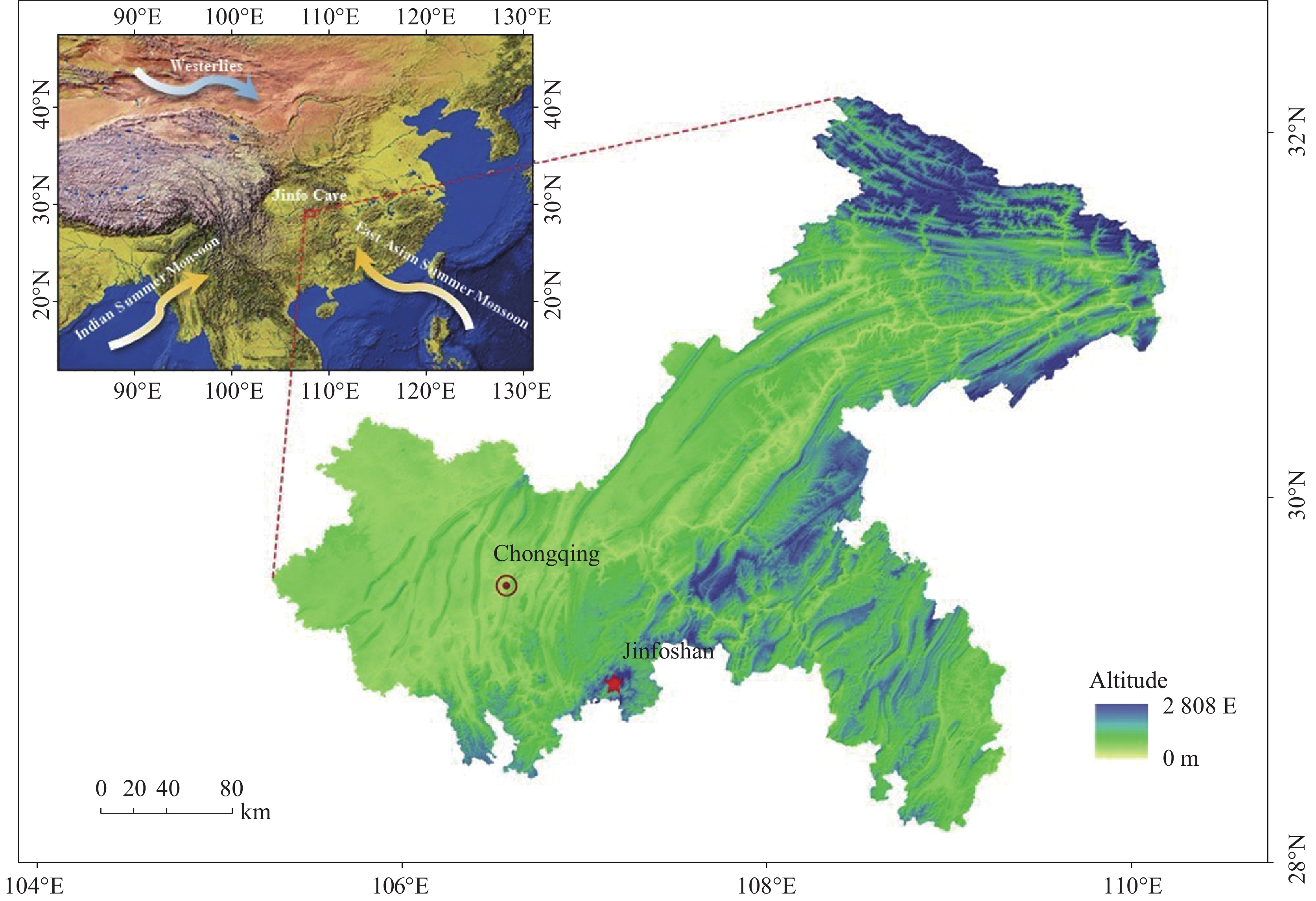
 下载:
下载:
